About
Special News
Logan's Page
Jacoby's Page
Our Travel Index
Tracks Ahead Related Trips
Contact
Portugal & Spain Sept 28 – Oct 11, 2024
Portugal & Spain

 |
The long delayed cruise
on the Douro and Barcelona. .
|
Introduction
The video files are of low resolution and are in
AVI format. They must be downloaded and then played. I could
have embedded them, but then you have to "Allow Blocked Content" and
they play continuously, which I find dreadfully annoying. This
way, if you want a video clip, download and play. Otherwise. skip
it.
Saturday/Sunday,
September 28/29
Our flight out of Phoenix was delayed due to high runway temperatures.
Air temperature on the runway was 46°C, one degree over the maximum
recommendation for takeoff.
We waited about forty- five minutes for things to cool down and even
then, used what seemed to be all of the runway.
We and our friends were off on our adventure.
The plane was comfortable with flat, folding seats, and plenty of
entertainment options. I
slept all night, even through breakfast.
We landed at Heathrow, and the usual madhouse which is that airport.
The next leg was right on time to Lisbon.
We were fed again.
Food and drink, sleep, repeat.
Our arrival in Lisbon concluded at the Corinthia Hotel, a lovely
place a bit on the outskirts of the city proper.
Here we are and it is off to bed.
Monday, September 30
Welcome to Portugal, which has a population of around 10 million, with
around three million in Lisbon.
We started our first day by meeting our guide Margarida and driver
Patelmo (?), in the lobby this morning at 9 o'clock.
We headed off for the town of Sintra, so named for the mountain
range, the highest peak of which is just over 500 meters.
The quaint town is located just to the north of Lisbon.
From what I had read, almost the whole town is a World Heritage
Site. There are many
palaces and because it is higher in the hills and close to the ocean,
has its own microclimate.
It was a cooler, summer retreat for the wealthy and nobles.
I believe the area also served as a retreat from the devastating
earthquake and fire of November 1755 and resulting tsunami which killed
an estimated 40-50,000 people.
Our introduction to the town showed us narrow streets, steep grades, and
lots of tourists. Traffic
was dense. On the positive
side, it was charming and lovely.
 The
first stop was Pina Palace.
We had prearranged tickets which were timed.
I would suggest that should you want to do this, hire a guide and
arrange for a private tour.
The
first stop was Pina Palace.
We had prearranged tickets which were timed.
I would suggest that should you want to do this, hire a guide and
arrange for a private tour.

Otherwise expect a great deal of waiting and milling about.
Because the architect was from Bavaria, the palace reflects German and
Moorish architectural influences and sits at the highest point above the
town. There is a great deal
of colored tile which was used not just for decorative purposes but to
keep the walls low maintenance.
 The
rooms were displayed with artifacts of the time.
As always, it was good to be king.
The wall coverings, room décor and furnishings were well
displayed and lovely.
The
rooms were displayed with artifacts of the time.
As always, it was good to be king.
The wall coverings, room décor and furnishings were well
displayed and lovely.

The small chapel was interesting, with a lovely altar, and beautiful
stained glass windows.
 I
believe that the last Portuguese Monarchy lived here.
Other nobles’ houses are built below this structure.
As the Portuguese traveled widely; they brought back plants from
all over the world. As a
result, you will see all sorts of oddities from around the world.
Palm trees, flowering shrubs, all sorts of things that make this
a bit of a horticulturist’s delight.
I
believe that the last Portuguese Monarchy lived here.
Other nobles’ houses are built below this structure.
As the Portuguese traveled widely; they brought back plants from
all over the world. As a
result, you will see all sorts of oddities from around the world.
Palm trees, flowering shrubs, all sorts of things that make this
a bit of a horticulturist’s delight.
 Portugal
produces a great deal of the world's cork.
We stopped by a tree which was close to the road, which tourists
have been attacking. They
peel a little bit off as a souvenir which will eventually kill the tree.
Cork plantations consist of cork oak groves.
It takes about forty years for the whole process.
After the first twenty years, the rough bark is peeled.
The next layers grow smoothly and are peeled back every nine
years.
Portugal
produces a great deal of the world's cork.
We stopped by a tree which was close to the road, which tourists
have been attacking. They
peel a little bit off as a souvenir which will eventually kill the tree.
Cork plantations consist of cork oak groves.
It takes about forty years for the whole process.
After the first twenty years, the rough bark is peeled.
The next layers grow smoothly and are peeled back every nine
years.
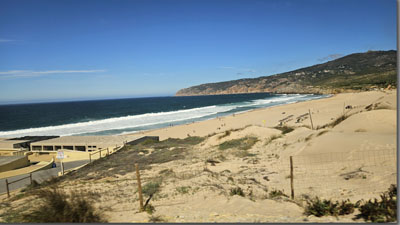
We did not view any more of the palaces, other than from afar.
We drove along the coast and were treated to lovely views of the
Atlantic and the coastal dunes.
Lunch was at a lovely seaside restaurant.

In view was the western most point in Europe, which sits almost directly
across from New York.
 After
lunch, we drove into Cascais.
We walked the town a bit, purchased some minor trinkets, and then
moved on back to Lisbon. The streets are cobblestone, so our feet and
calves suffered.
After
lunch, we drove into Cascais.
We walked the town a bit, purchased some minor trinkets, and then
moved on back to Lisbon. The streets are cobblestone, so our feet and
calves suffered.

Once
there we had to stop to see The Discoverer’s Monument, which is a
tribute to all the explorers who left Portugal to explore the world.
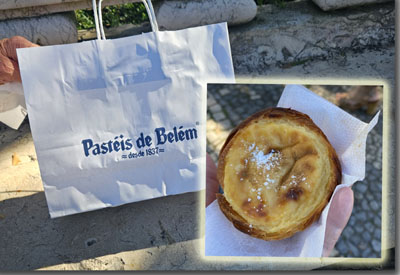 We
also had an afternoon snack, the famed Pasteis de Belem (Bethlehem,)
which is basically a filo dough cup filled with custard.
This delicacy goes by many names (Pasteis de Nada, etc.) as this
name was copyrighted by the monks who concocted it.
We
also had an afternoon snack, the famed Pasteis de Belem (Bethlehem,)
which is basically a filo dough cup filled with custard.
This delicacy goes by many names (Pasteis de Nada, etc.) as this
name was copyrighted by the monks who concocted it.
It seems that when the clergy was ousted in 1821,
 the
monks who stayed were forced to go to work.
No more staying in lavish digs such as this.
The resulting egg tart was their copyrighted special bakery
product. Sprinkled with
cinnamon and powdered sugar, they are an excellent treat.
the
monks who stayed were forced to go to work.
No more staying in lavish digs such as this.
The resulting egg tart was their copyrighted special bakery
product. Sprinkled with
cinnamon and powdered sugar, they are an excellent treat.
Our final stop was the new Royal Treasure Museum.
No photos were allowed so you’ll have to take my word for it.
It was dark, glass, mirrored, and somewhat disorienting.
It was filled with jewels, clothing and artifacts from the past
rulers. As Portugal took
much wealth from Brazil, we saw big gold nuggets, emeralds, diamonds,
and other rare stone and other items from the New World.
 On
the way back to the hotel we passed a portion of a Roman aqueduct.
These items are still standing and a testament to the skill of
the Roman builders. The
secret sauce in the mortar turned out to be calcium from human bones.
On
the way back to the hotel we passed a portion of a Roman aqueduct.
These items are still standing and a testament to the skill of
the Roman builders. The
secret sauce in the mortar turned out to be calcium from human bones.
I should mention the 1755 All Saints Day earthquake which leveled
Lisbon. As November 1 was a
religious holiday, the churches had many lighted candles.
The earthquake struck, and people rushed to the river for safety.
As the churches collapsed, fires started.
Cue a resultant tsunami which killed between 60-100,000 people.
The resulting water was not enough to extinguish the fires, so
things just continued to burn.
We are back at the hotel and glad to be sitting down.
Tuesday, October 1
After a rather sleepless night we headed out for our trip to Porto, and
the boat, the Viking Helgrim, on the Douro River.
 We
started driving north out of Lisbon, passing through a series of
mountains, which were actually used as a defensive line against the
invading French. Of note is
the good relationship the British have always had with Portugal
We
started driving north out of Lisbon, passing through a series of
mountains, which were actually used as a defensive line against the
invading French. Of note is
the good relationship the British have always had with Portugal
Our guide offered details on the education system.
It seems pretty rigorous and intense. University tuition is
artificially kept low €750, but there are only about 7000 slots in
Portuguese universities throughout the year. The students have to pay
for their own housing and meals
The problem is that once everybody's prepared - and they appear to be
well prepared - the local salaries are not high enough to pay for a good
standard of living. As a
result, most of the best and brightest leave for other countries and
higher salaries.
Portugal gets most of its power needs from wind, solar, and hydro.. They
currently export power to two other countries. They do have some
residual coal, but there's no natural gas and no oil. The country
expects to be fully powered by renewables by 2030.
Portugal is a very big olive producer and one of the top five in the
world. We had a little bit of rain today, so the trees are all quite
happy.
Forestry is also a big industry with Eucalyptus trees harvested for
pulp. That tree is an
invasive species so this keeps the numbers down.
They are very fast growing and burn very hot. The country had
some large fires this year.
Many of the fires were set by arsonists and the country has started
rounding up known persons and monitoring their movements.
Once they started doing that, fire instances decreased.

Our first stop was Coimbra which was originally the capital of Portugal.
It was so designated after the 1755 earthquake as the town is
built on granite, so was unaffected by the tremors.
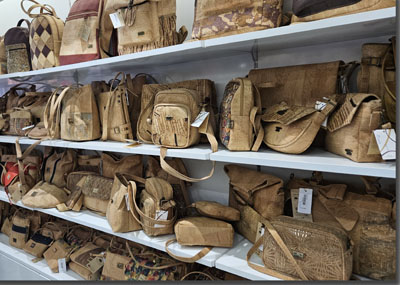
The initial stop was – shopping!
Coimbra is a site for direct-to-consumer cork product sales, and
of course, we succumbed.

The narrow streets and arrays of products made for any enjoyable and
productive experience.

It is here that we toured one of the oldest universities in the world.
The University of Coimbra was founded in 1290.
There are many traditions here, one of which is the black cloaks
worn by both male and female students.
The cloaks inspired JK Rowling with her depiction of the garb
used in the Harry
Potter books.
 We
toured the library. The
library has some 56,000 volumes, all on wooden aromatic oaken shelves
and open to the air. In
order to keep the books insect free, the space is open to bats every
evening. The tables and
chairs are covered, the bats swoop in, eat the insects and in the
morning the place is readied for business.
They also still use cats to catch the rodents.
We
toured the library. The
library has some 56,000 volumes, all on wooden aromatic oaken shelves
and open to the air. In
order to keep the books insect free, the space is open to bats every
evening. The tables and
chairs are covered, the bats swoop in, eat the insects and in the
morning the place is readied for business.
They also still use cats to catch the rodents.

Of
course, there is a lovely chapel with a great pipe organ.
Yet another example of liturgical ostentation.
We had a nice lunch accompanied by fado singing and
guitar music.
The music is characterized by mournful tunes and lyrics, often
about the sea or the life of the poor, and infused with a sense of
resignation and fate.
 We
finally ended up at the ship and settled into our lovely suite for the
next seven days.
We
finally ended up at the ship and settled into our lovely suite for the
next seven days.
 Of
course, we had to do the mandatory lifeboat emergency drill.
We all fumbled with our vests.
If something happens, I always wonder how many people would still
be totally confused.
Of
course, we had to do the mandatory lifeboat emergency drill.
We all fumbled with our vests.
If something happens, I always wonder how many people would still
be totally confused.
It's great to be “home” for a week.
Unpack once. Great.

As
soon as we were settled, the Viking Helgrim sailed out of Porto,
starting our river tour.
Wednesday. October 2
We got to sleep in a bit this morning.
No getting up at “Stupid O’Clock..”
After breakfast we had a talk
 on
the on the history of the Douro Valley
Wine has been produced here for a long time, first by the Celts
and then later by the Romans and then through various through the
following years
on
the on the history of the Douro Valley
Wine has been produced here for a long time, first by the Celts
and then later by the Romans and then through various through the
following years
 We
were left on a rainy day to simply enjoy the passing countryside and the
little towns that dotted the shores of the river.
We
were left on a rainy day to simply enjoy the passing countryside and the
little towns that dotted the shores of the river.
The river can be quite narrow at points.
I spent some time in the wheelhouse to watch how the crew handled the ship.
The use of a GPS system and exact markers allows the pilot to
point the boat along a line.
As long as there is no deviation from that line (following the
channel) all is well.
 We
passed through several locks which are guillotine locks, meaning that
the gates go up and down.
We are used to swing gates, having grown up on the Mississippi, so these
were a novelty. The boats
are specifically designed to fit into the lock channels and to clear the
gates.
We
passed through several locks which are guillotine locks, meaning that
the gates go up and down.
We are used to swing gates, having grown up on the Mississippi, so these
were a novelty. The boats
are specifically designed to fit into the lock channels and to clear the
gates.
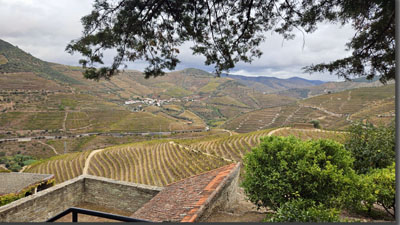 I
had no idea how mountainous the land would be.
It is really lovely.
The soaring bridges and twisting roads are all the work of the EU and
have really helped to open up the country.
I
had no idea how mountainous the land would be.
It is really lovely.
The soaring bridges and twisting roads are all the work of the EU and
have really helped to open up the country.
There are three major sub-zones within the Douro Valley: Douro Superior
(sometimes called Alto Douro), Cima Corgo (home to the very high-end
Ports) and Baixo Corgo (Lower Corgo).
They are delineated by elevation and subsequently climate. With
the higher being hotter and more arid.
Why wine? Because as is the
usual story, the water was unsafe to drink.
Watered down wine was the liquid of the day.
Original production, like most of early European industry, was
run by the monasteries.
However, the people who worked the land were held as slaves or serfs
until the government said, “Enough.”
 In
the mid 19th century, this area, like most vineyards suffered
from phylloxera. People
were dying, selling everything they had, including their land, and
fleeing.
In
the mid 19th century, this area, like most vineyards suffered
from phylloxera. People
were dying, selling everything they had, including their land, and
fleeing.
Enter one Antónia Adelaide Ferreira.
Born into a family of wine producers and port traders, married
off to a cousin, she was widowed at age 33.
She took over the family business
and allocated resources into the production and trade of Port
wine. Her vision, courage,
and entrepreneurship allowed her to become the most prominent landowner
in the Douro Valley. Her
life was interesting and too much to relate here.
She survived a shipwreck, supposedly buoyed by her large skirt
and was very active in local politics.
She is revered for her saving of the wine production by
purchasing the failing farms, keeping the owners in place, feeding and
caring for them until a solution to phylloxerae epidemic was tamed.
This was done with new root stock from America, which were
resistant to the plague.
Much of her land was in the furthest inland areas, and accessible only
via the Douro River, which was a wild, rapids filled torrent and hardly
navigable. Casks were only
filled to about 60% so that when the ferry crashed (not if, when) they
would float toward the Atlantic.
Finally a railway line was built along the banks, which eased
transport, and after the EU was joined, a series of dams and locks were
built making the river scenic, navigable, and host to the tourist trade.
Remember that the British and Portuguese were pretty tight.
Due to continued spats with the French (and thus French wines)
the UK got its wine from Portugal.
However, the wine was spoiling on the long sea voyage to the
British Isles as fermentation continued all along the way.
Enter brandy, which was added to the wine in about 25 % volume.
This killed the yeast and stopped the fermentation.
As I understand it, Port wine was born.

We docked at Lamego to start our tour portion.
We started at the Mateus Estate, which was old and musty.
It was filled with the standard chests and artifacts from the
Baroque and Chinois Periods, chestnut ceilings, etc..
The ship, meanwhile, sailed on to Pinhao.

The whole thing was rather dark.
The government said that to keep it open as a tourist attraction
(probably tax advantage) the family had to live there three months of
the year. The library did
appear to be well stocked, and there was a display of period artifacts.
The chest and insets were of particular interest.

Of interest is that while we are all familiar with Mateus from our early
drinking days, the wine has nothing to do with this family except by
name. A grower approached
the family back at the onset of the production and said, “Your house is
the perfect label photo for our wine.
I’ll make you a deal.
I’ll pay you a lump sum up front for use in perpetuity, or you
can have a small percentage of each bottle sold.”
The head of the family took the lump sum. Bad idea, as millions
of bottles have been sold over the years.
Apparently, the contract was renegotiated a few years back but
there were many years of bad blood.
 The
second visit was up a narrow twisting road to the Sandemann winery.
This is a large operation and comprises six estates.
Wine pressing, bottling, fermenting - the whole process is
automated. While the presing is
indeed automated, each season a whole group of people get together for
the traditional "stomping of the grapes." They (I think) take one
bin, and press the grapes the old fashinoned way. It's a working
party, with much gossip, laughter and general good times.
The
second visit was up a narrow twisting road to the Sandemann winery.
This is a large operation and comprises six estates.
Wine pressing, bottling, fermenting - the whole process is
automated. While the presing is
indeed automated, each season a whole group of people get together for
the traditional "stomping of the grapes." They (I think) take one
bin, and press the grapes the old fashinoned way. It's a working
party, with much gossip, laughter and general good times.
There were eight
pressing bins, each of which would yield about 19,000 liters of juice.
Of course, we liberally sampled.
I asked how many people it took to perform the harvest.
Our guide said that they would prefer 50 to hand pick all those
vines) but generally were lucky to get 30.
The workforce is mostly older as the young people leave the area
for urban areas and better paying jobs.
 I
should mention that there are three types of port: white, ruby, and
tawny. Each has a slightly
higher alcohol content than the latter.
I
should mention that there are three types of port: white, ruby, and
tawny. Each has a slightly
higher alcohol content than the latter.
We were there.
Pinhao is the end of the line for the Douro Railway .
While the line no longer services this station, the
infrastructure is still in place.
There was a rather rusty tank engine sitting forlornly on a
siding, but other than that, there was no activity.
As we were just passing by, this photo is the best I could do.
.
While the line no longer services this station, the
infrastructure is still in place.
There was a rather rusty tank engine sitting forlornly on a
siding, but other than that, there was no activity.
As we were just passing by, this photo is the best I could do.

Thursday, October 3
 We
spent the morning sailing up the Douro.
Our destination today is the pier at Barca de Alva.
We transited two lock sets before we stopped for our first tour.
The Sun was finally out and it was really quite scenic.
We
spent the morning sailing up the Douro.
Our destination today is the pier at Barca de Alva.
We transited two lock sets before we stopped for our first tour.
The Sun was finally out and it was really quite scenic.
 These
are the Estrella Mountains of which the highest peak is Pico, at 2,300
meters.
These
are the Estrella Mountains of which the highest peak is Pico, at 2,300
meters.
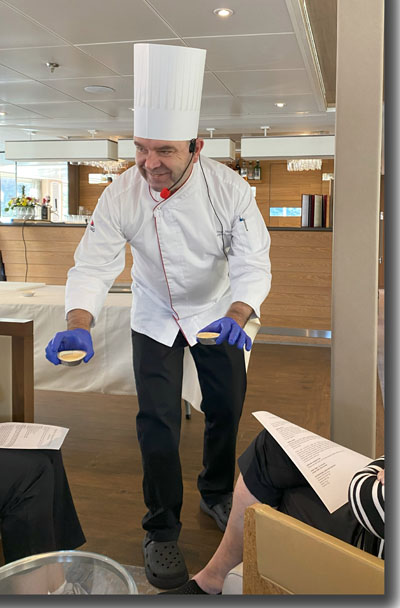
I dawdled around for the morning, while Barb took off for a cooking
class. She learned how to
make the Patisse de Belem, the little custard tarts.
They are delicious and so I hope to be treated once we get back
home.

Our first stop was at Pocinho where we departed for a luncheon and tour
of the semi-restructured medieval town of Marialva.
Up until recently the town was pretty much deserted.
A couple came in, found the place charming, started buying up the
dilapidated
houses and turned the place into the charming Casas Do Coro hotel.
 We
had lunch there. A typical
Portuguese lunch includes soup and fish.
Cod is a diet staple.
There were plenty of fresh tomatoes, lettuce, cheese, chocolate
and of course, lots of wine.
We
had lunch there. A typical
Portuguese lunch includes soup and fish.
Cod is a diet staple.
There were plenty of fresh tomatoes, lettuce, cheese, chocolate
and of course, lots of wine.

We had a bit of an opportunity to
explore the grounds, and peek in on the dining areas for the resort.
It seems quite lovely and attracts those seeking a slower pace
from all over the world.
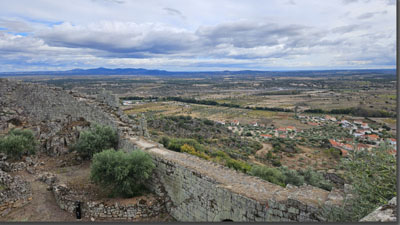
We walked up to the old fort which was right at the same level as the
resort. The place was built
as a watch
point against the potentially invading Spanish.
It was – like most of these old structures, built on the
foundation of a pre-history tribe, followed by the likes of the Celts,
the Romans, the Moors, and so on.

It has a solid keep and towers which stand out in the landscape.
What is amazing is how tight the stones fit together.
All this was done with hammer and chisel.

There are two chapels, the Sao Tiago and Nossa Senhora dos Passos.
Both have Baroque alters and are still attended on a weekly
basis.
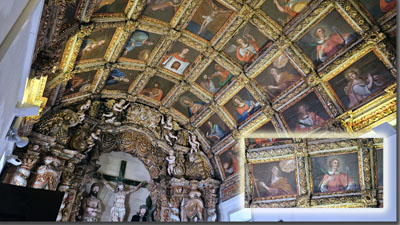 Note
the ceiling and illustrated décor.
Note
the ceiling and illustrated décor.
Our guide, Carlos, was born here and grew up under the care of his
grandmother. His university degree is in history and he guides and does
research.
 Back
to the ship on twisty, narrow roads.
Think Mexico’s Copper Canyon with better equipment.
Thursday's dinner consisted of a taste of Portugal, which was a
giant buffet. Notable items
included sardines in tomato sauce which were delicious.
Back
to the ship on twisty, narrow roads.
Think Mexico’s Copper Canyon with better equipment.
Thursday's dinner consisted of a taste of Portugal, which was a
giant buffet. Notable items
included sardines in tomato sauce which were delicious.
As usual, we overate and were entertained by a demonstration of Flamenco
dancing.
Friday, October 4
We are right at the border between Spain and Portugal.
It is here we turn around and sail back toward Porto and the
Atlantic. We were up and
out early for a two-hour bus ride to Salamanca, Spain.
Now we can check that country off our list.
Salamanca is a fair size town, although everything was pretty walkable
and obviously a tourist destination.
You can see why the locals would hate the tourists coming up as
even this late in the season, things were crowded.
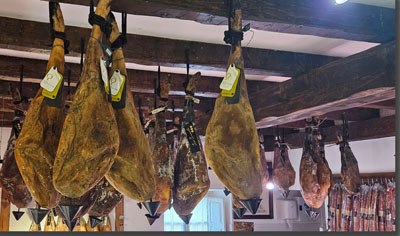
We started at a food market, with lots of yummy goods on display.
The ham is of particular mention.
It is very popular here.
Some of the pork is entirely acorn fed and has a special taste.
That can be quite expensive going for as much as €400 per front
haunch.
The market held more than just meats.
Fresh vegetables, seafood, and a
 wide
variety of spices and foodstuffs were on display.
Come, shop fresh, and take it home for dinner.
wide
variety of spices and foodstuffs were on display.
Come, shop fresh, and take it home for dinner.
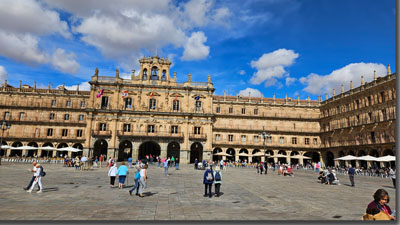 We
started in the main square, the Plaza del Toro, obviously so named
because it was built to handle bull fights.
Alas no more bull fighting of the old sort.
Now the matador has to take garlands from the horns of the bull.
The one thing that has stayed the same is that the bull is killed
at the end of the match.
We
started in the main square, the Plaza del Toro, obviously so named
because it was built to handle bull fights.
Alas no more bull fighting of the old sort.
Now the matador has to take garlands from the horns of the bull.
The one thing that has stayed the same is that the bull is killed
at the end of the match.
The symbol of Salamanca is a frog.
It is also a tie to the university, which is the third oldest
university in Europe. If
you spot the university frog, it
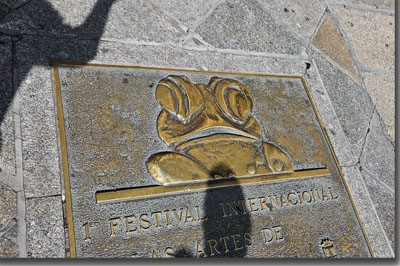 means
that you will return at some point.
Apparently, we will return, as there is a frog carved in to the
plaza stones. Will we?
Time will tell.
means
that you will return at some point.
Apparently, we will return, as there is a frog carved in to the
plaza stones. Will we?
Time will tell.

We walked to the main cathedral which we [jadedly] considered just ABC.
I took some photos and we were gone.
Of note though, is that there is a “new” cathedral, and an “old”
cathedral. The new one was
started after the 1755 seismic activity and the original bell tower
started to lean. The
construction took so long (200 years) that people continued to use the
old one. That goes on
today. There was the usual
religious wealth on display.
In back of the cathedral was, IMHO, the gem of the area; Casa Lis, the
Art Nouveau museum. Wow.
While there was a rather creepy doll display from the era, the
beautiful glass pieces, bronzes, ceramics, toys, furniture, and wooden
items were stunning. The little coffee shop had a wonderful,
stained-glass ceiling, and windows.
The guards were strict about no photography, so you will either
have to take my word for it or make a visit.
We wandered our way back to the plaza. It sat in a cafe for a while,
rather than take the shopper shuffle walking tour.
We settled for a beer and some tapas, only to find out that upon
leaving the plaza – we were fed again.
Yikes.
Then it was back to the bus for the two-hour ride back to the ship.
Frankly, there was much dozing, particularly on my part.
The roads are something else. When Portugal joined the EU in 1987, tons
of money was poured into the country to improve the infrastructure.
The roads are relatively new and while twisty and curvy, quite
good. Of course, the
terrain lends itself to mountain hugging tracks as well as soaring
bridges. Driving in the
snow or the dark I think would be a challenge.
 As
always, I was focused on the rail system.
The Douro Line, previously mentioned, was displayed as a nifty
tile on the side of a disused station.
As
always, I was focused on the rail system.
The Douro Line, previously mentioned, was displayed as a nifty
tile on the side of a disused station.
Dinner is again a taste of Portugal.
The adventure continues.
Saturday, October 5
The sun was out today as we left the ship for our look at muscatel wine.
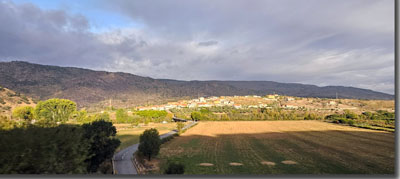 We
are still in mountains, but had to climb higher as that particular grape
likes a more rarified attitude.
That particular grape tends to be sweeter with a 17% alcoholic
content.
We
are still in mountains, but had to climb higher as that particular grape
likes a more rarified attitude.
That particular grape tends to be sweeter with a 17% alcoholic
content.
By the time we got to our destination, Favaios, it was foggy and
raining.
 We
toured the automated winery which was just a the end of the processing
cycle. Basically we viewed
many inert stainless tanks and apparatus, as well as the more
interesting wine cellar with loads of barrels.
Of course, tasting commenced.
We
toured the automated winery which was just a the end of the processing
cycle. Basically we viewed
many inert stainless tanks and apparatus, as well as the more
interesting wine cellar with loads of barrels.
Of course, tasting commenced.
We move then to the town center and a bakery.
The town is home to four
 corners
bread. It is so named
because the dough is pulled into a small square.
Of course, there were samples to be had.
One of the older bakers makes (I think) around 900 loaves a day
and has been doing so for most of her life.
The process could be automated, but she resists, saying that the
old manner of doing so makes for a better product.
The Viking ads feature a shot of an older woman baker making
these loaves. This is the
place where that was shot.
It was warm and inviting with that good, fresh bread smell.
corners
bread. It is so named
because the dough is pulled into a small square.
Of course, there were samples to be had.
One of the older bakers makes (I think) around 900 loaves a day
and has been doing so for most of her life.
The process could be automated, but she resists, saying that the
old manner of doing so makes for a better product.
The Viking ads feature a shot of an older woman baker making
these loaves. This is the
place where that was shot.
It was warm and inviting with that good, fresh bread smell.

Barb and I sat out the wine and bread museum tour as it was a “museum
shuffle” operation. I did
catch the highlights which were that there were originally five
competing families that eventually merged into one conglomerate.

Then it was on to lunch, with – of course – more wine.

A view of the hills and valleys as we descend back to Pochino and the
banks of the Douro.
The highway infrastructure is up to date.
When the EU took in Portugal
 back
in 1987, they pumped a great deal of money into the roads and bridges.
The results are on display in the number of soaring bridges
across the river and the valleys.
back
in 1987, they pumped a great deal of money into the roads and bridges.
The results are on display in the number of soaring bridges
across the river and the valleys.
 Before
dinner on board tonight, we had a “your favorite drink” cocktail hour.
The bartenders made up a plethora of what I call froo-froo
drinks. All were yummy .
Apparently, the secret to a happy passenger consist is plenty of
alcohol. It worked as a fun
time was had by all.
Before
dinner on board tonight, we had a “your favorite drink” cocktail hour.
The bartenders made up a plethora of what I call froo-froo
drinks. All were yummy .
Apparently, the secret to a happy passenger consist is plenty of
alcohol. It worked as a fun
time was had by all.
Sunday, October 6
This morning’s tour was to the small towns of Lamego and Touruca.
We learned about the Cistercians and their remaining monastery
and chapel. That particular
order of the Bendictines was quite powerful until around 1821 when the
king decided they had too much power and basically tossed them out of
power. They had something
like a week or two to leave their monasteries.
Leave the country or get a job – see Patisse de Belem.
The whole thing, was, “No, you can’t take the valuable stuff you
have acquired, only when you can carry, and get out.”

First stop was the church – San Pedro, where we had to wait for someone
to arrive to open the place.
All of us tourists, warm and dry on the bus.
Waited. And waited.
Eventually we got to the see the place and the ostentatious
interior. Lovely paintings,
gilded alters, superb tiles – all a look at the immense wealth of the
clergy.
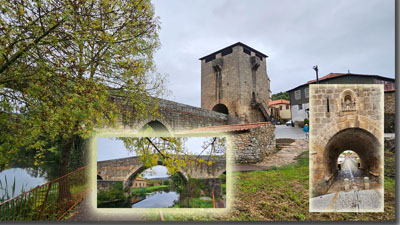 Upon
completion of our tour, we spent a little time in the town itself.
There was a Roman bridge, the Ponte Forticada de Ucanha, still in
use, with its toll collection point.
This was the first toll bridge in Portugal, or so the signs said.
Upon
completion of our tour, we spent a little time in the town itself.
There was a Roman bridge, the Ponte Forticada de Ucanha, still in
use, with its toll collection point.
This was the first toll bridge in Portugal, or so the signs said.
 The
town was charming and is said to be the gateway to the Douro Wine
Regions. We found the usual
narrow cobblestoned streets.
Every doorway seems to make a statement about the place.
Overall, it seemed very likeable, livable
and charming.
The
town was charming and is said to be the gateway to the Douro Wine
Regions. We found the usual
narrow cobblestoned streets.
Every doorway seems to make a statement about the place.
Overall, it seemed very likeable, livable
and charming.
We stopped at yet another winery for a tasting.
The tasting room at the
 San
Britiandi Winery was cozy, with a blazing fire, which was welcome after
the foggy and chilly rain.
The woman who ran the place did the samples and talked a bit about her
operation. We are drinking
before Noon once again.
San
Britiandi Winery was cozy, with a blazing fire, which was welcome after
the foggy and chilly rain.
The woman who ran the place did the samples and talked a bit about her
operation. We are drinking
before Noon once again.
I can see why Americans would want to come live here. The terrain is
gorgeous. It is quite
hilly, much like Dubuque, where we grew up.
But think sleeper slopes, lots of vineyards and tons of greenery.
While it is hot in the summer it never really gets cold enough to
snow unless you're high
 in
the mountains. I checked
the price of housing and appears to be pretty reasonable.
While I can't say the same about food or other amenities, it
certainly would be worth investigating.
I think I'd have to be about 30 years younger to do so, but it
would be quite relaxing and off the grid.
Living here in the Douro Valley would be pretty sweet.
in
the mountains. I checked
the price of housing and appears to be pretty reasonable.
While I can't say the same about food or other amenities, it
certainly would be worth investigating.
I think I'd have to be about 30 years younger to do so, but it
would be quite relaxing and off the grid.
Living here in the Douro Valley would be pretty sweet.
There are many electric cars here.
I even saw an electric MG of all things.
There appears to be the infrastructure to support the cars, with
charging stations along the streets at parking meters.
With fuel at €1.64/liter, it’s no wonder.
The Linho de Douro rail line parallels the river, and frankly could be a
short excursion for rail fans.
While I saw the train, I was not able to get a photo.
Looking at the timetable, there are only two daily runs. I
finally obtained a glimpse, which was obscured by the shoreline brush.
Much to my dismay, no photos!
 So
we head on down the Douro, with docking in Oporto tonight.
It is again, misty and somewhat foggy.
So
we head on down the Douro, with docking in Oporto tonight.
It is again, misty and somewhat foggy.

As evening started, we watched the sun sink into the Atlantic from just
inside
the harbor.
After dinner, we were treated to local music by a group from the local university.
It was a nice way to end the evening.
Monday, October 7
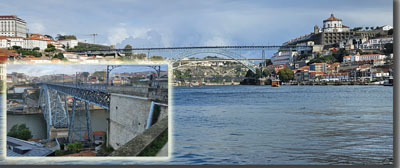 We
were again greeted today by rain.
That did not deter us from a walking tour of Porto.
We took a bus to a high point in the city and walked across an
iron lattice bridge. If you
think that the work looks a bit familiar, compare it to the work of the
Eiffel Tower. Gustav Eiffel
designed the Maria Pia Bridge in 1877.
At the time, it was considered one of the longest single arch
spans.
We
were again greeted today by rain.
That did not deter us from a walking tour of Porto.
We took a bus to a high point in the city and walked across an
iron lattice bridge. If you
think that the work looks a bit familiar, compare it to the work of the
Eiffel Tower. Gustav Eiffel
designed the Maria Pia Bridge in 1877.
At the time, it was considered one of the longest single arch
spans.

The Metro runs down the middle with tourist traffic on the upper deck
and vehicles on the lower deck.

The
city also has a funicular which takes people from river level up to the
top of the hills.

We started the tour with – of course – the Porto Cathedral, a major
church of the city and a view of the enormous wealth amassed by the
clergy. As Lynn said,
another example of liturgical ostentation.
In my jaded opinion ABC.

No trip that we are on would be complete without at least a cursory
glance at the trains. This
was no exception. Here the
platforms were easily accessible and offered a view of the modern rail
system.
The station itself was centrally located, and notable for
 it’s
tiled walls. The walls
themselves were colorful, and the upper border depicted the history of
transportation through the ages.
We start with foot traffic, progress to Roman carts, oxen and
horse and finally to the iron horse.
What was interesting was that the animals were all tiled in
profile, while the train was depicted in a head-on pose.
It showed the enormous power and leap in speed that the railroad
offered.
it’s
tiled walls. The walls
themselves were colorful, and the upper border depicted the history of
transportation through the ages.
We start with foot traffic, progress to Roman carts, oxen and
horse and finally to the iron horse.
What was interesting was that the animals were all tiled in
profile, while the train was depicted in a head-on pose.
It showed the enormous power and leap in speed that the railroad
offered.
 The
town itself was busy, busy, even on this rainy day.
Portugal has always been a trading nation, and the town was built
to serve commerce. Our
guide said that the wealthy merchants would construct each building with
three entrances: the shop entrance, one for the family living quarters,
and a third for the upper stories, which could be used as servants’
quarters, or leased out as apartments.
Kitchens were often at the top of the building so that a fire
wouldn’t take down the whole structure.
As industrialization took hold, cheap labor was needed.
The upper quarters, and much of the buildings, were subdivided
into ever smaller apartments to house factory workers.
The housing was all rent controlled, so maintenance was an
afterthought. Eventually
this became quite a poor area, with much crumbling and disrepair.
Up until the EU came thirty years ago, the center of town was
terribly depressed and crumbling.
Enter urbanization.
The buildings were cheap to purchase, although they needed extensive
work for habitation. Our
guide said that years ago you could have purchased one of these for
virtually nothing, and sold it today at a huge profit.
Like most cities with vast building projects, the industrial
crane is the national bird.
The
town itself was busy, busy, even on this rainy day.
Portugal has always been a trading nation, and the town was built
to serve commerce. Our
guide said that the wealthy merchants would construct each building with
three entrances: the shop entrance, one for the family living quarters,
and a third for the upper stories, which could be used as servants’
quarters, or leased out as apartments.
Kitchens were often at the top of the building so that a fire
wouldn’t take down the whole structure.
As industrialization took hold, cheap labor was needed.
The upper quarters, and much of the buildings, were subdivided
into ever smaller apartments to house factory workers.
The housing was all rent controlled, so maintenance was an
afterthought. Eventually
this became quite a poor area, with much crumbling and disrepair.
Up until the EU came thirty years ago, the center of town was
terribly depressed and crumbling.
Enter urbanization.
The buildings were cheap to purchase, although they needed extensive
work for habitation. Our
guide said that years ago you could have purchased one of these for
virtually nothing, and sold it today at a huge profit.
Like most cities with vast building projects, the industrial
crane is the national bird.
 Then
we headed to Flower Street, which was lined with tourist shops.
The walk was downhill, and as such, I took off on my own,
purchasing some small items as I descended to river level.
I was not going to walk back up the cobblestones to meet the
guide, just so that I could walk back down again.
I ended up at the river taxi, which I took across to the docks
were our boat was tied up.
Then
we headed to Flower Street, which was lined with tourist shops.
The walk was downhill, and as such, I took off on my own,
purchasing some small items as I descended to river level.
I was not going to walk back up the cobblestones to meet the
guide, just so that I could walk back down again.
I ended up at the river taxi, which I took across to the docks
were our boat was tied up.

The evening dinner concluded with fado music in the lounge.
Tomorrow we depart for Barcelona.
It’s been a delightful trip.
Tuesday, October 8
We were up and out of the ship quite early
We had to have the bags out at 4:45.
Ugh. Needless to
say, we did not sleep particularly well.
The Porto airport is large but getting through security and emigration
was a snap with our upgraded tickets.
On the other hand, the flight was packed. I didn’t think they could
crowd that many people on an Airbus 320.
Note to self – don’t book Vueling.
 On
to Spain, which has a population of around 40 million.
Four million of those people live in Barcelona, the final stop of
our trip. We were told that
last year around two million tourists came through here.
In all of Spain, 2024 figures show around 90 million tourists.
It’s no wonder the locals love them and hate them.
They like the dollars, but they hate the crowding and the ensuing
rising property costs.
There were crowds everywhere and loads of tourist buses.
On
to Spain, which has a population of around 40 million.
Four million of those people live in Barcelona, the final stop of
our trip. We were told that
last year around two million tourists came through here.
In all of Spain, 2024 figures show around 90 million tourists.
It’s no wonder the locals love them and hate them.
They like the dollars, but they hate the crowding and the ensuing
rising property costs.
There were crowds everywhere and loads of tourist buses.
We checked into the Nobu Hotel, right across from the Barcelona Sant
rail station. I did not get
to see any trains, as the platforms were underground, and you had to
have a ticket. Boo.
Anyway, the Nobu is a
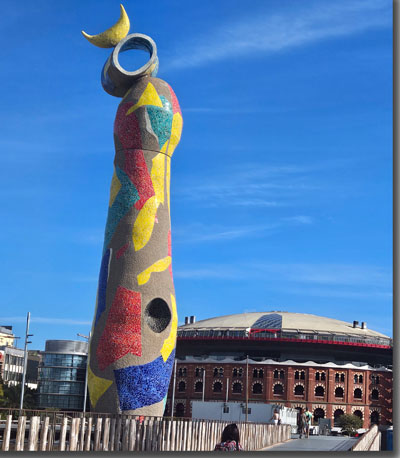 chain,
with a Japanese flair. The
lobby bar had wonderful tapas which sustained us at lunch.
One of our tour companions was from California and said that Nobu
was a pricey sushi restaurant in LA with month’s long waiting lists.
He was bound and determined to eat at this one, just so he could
say that he had been to Nobu!
chain,
with a Japanese flair. The
lobby bar had wonderful tapas which sustained us at lunch.
One of our tour companions was from California and said that Nobu
was a pricey sushi restaurant in LA with month’s long waiting lists.
He was bound and determined to eat at this one, just so he could
say that he had been to Nobu!
We tried the rooftop bar, but it was so windy that we gave up and headed
to the lobby bar for some tapas as a late lunch.
 We
walked a few blocks down to a shopping center which was a repurposed
bullring. A colorful urban
art piece was right along the way.
There are many bikes, motor scooters, and Lyme like scooters.
We were told that Barcelona is second only to Rome in motor
scooters. One had to be
careful when walking.
We
walked a few blocks down to a shopping center which was a repurposed
bullring. A colorful urban
art piece was right along the way.
There are many bikes, motor scooters, and Lyme like scooters.
We were told that Barcelona is second only to Rome in motor
scooters. One had to be
careful when walking.
More about the bullring.
While the interior housed many high-
 end
shops, the roof offered great city views and restaurants.
We had a drink, chose another place for dinner (paella) and
headed back to the hotel for an early turn in.
end
shops, the roof offered great city views and restaurants.
We had a drink, chose another place for dinner (paella) and
headed back to the hotel for an early turn in.
We did head back up to the rooftop, just to get a nighttime overview of
the city.
We were up early today.
Wednesday, October 9
We do not like this room.
While clean, I can’t control the HVAC, the bed is terrible, and there is
no place to sit. Ah well,
if not a good trip…. For a
couple of nights, it’s fine.
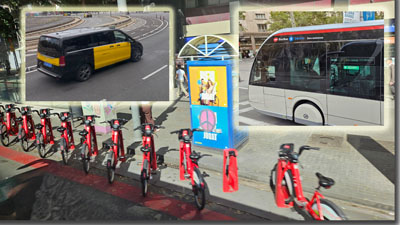
We opted for the included city tour this morning.
Again, lots of traffic and some 11,000 cabs running around.
One finds tons of rental E-Bikes, scooters, electric buses and
other various modes of urban modes of transport.
The bid deal here is Antoni Gaudi, the Catalonian visionary architect
and designer.
The big Kahuna is the cathedral, Sagrada Familia, which I’ll get to in a
minute.
 The
bus tour passed through tree lined city streets and the usual traffic.
The
bus tour passed through tree lined city streets and the usual traffic.
There are lots of the black and yellow taxis, and as there are roughly
11,000, it is no wonder their presence is some pervasive.
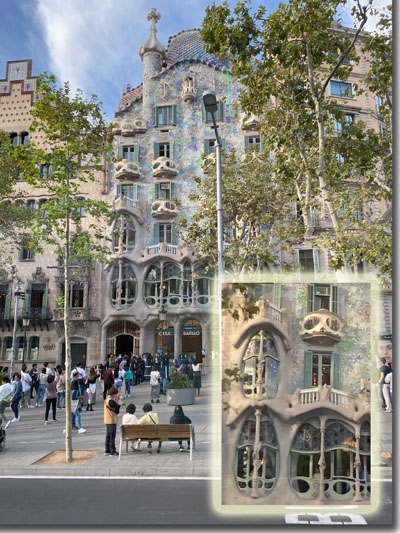 Gaudi
also designed many other structures, including houses here in Barcelona.
One is Casa Batllo, known as the House of Bones.
It has a colored roof and a rather skeletal appearance.
The balcony decorations and the window frames are flowing in the
Gaudi style. I think that
the guide said that each window is a different size.
No mass production here.
Gaudi
also designed many other structures, including houses here in Barcelona.
One is Casa Batllo, known as the House of Bones.
It has a colored roof and a rather skeletal appearance.
The balcony decorations and the window frames are flowing in the
Gaudi style. I think that
the guide said that each window is a different size.
No mass production here.
 The
bus tour passes several of these places, including the Casa Mila (La
Pedrera) which was built for a wealthy family of the same name.
The word “Pedrera” means “quarry” and due to the stone like
appearance of the structure, the name stuck.
The
bus tour passes several of these places, including the Casa Mila (La
Pedrera) which was built for a wealthy family of the same name.
The word “Pedrera” means “quarry” and due to the stone like
appearance of the structure, the name stuck.
As I mentioned, the big draw here is the
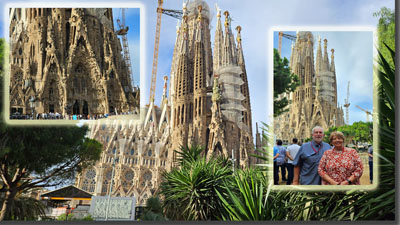 Sagrada
Familia cathedral. Started
in 1882, it is a unique building and frankly, looks like it is melting
concrete. The tactile
organic form offers an unusual artistic structure right in the middle of
the city with its bold flying buttressed and helical twisted towers
looming over the city.
Gaudi died in 1926 (hit by a trolley) at which time only about 25% of
the structure was done.
Work continued under several architects, working from drawings and
reconstructed plans for the building as many of the original plans were
destroyed during the Spanish Civil War.
In later years, the use of CAD technology greatly enhanced and
aided the design and construction of the place.
Sagrada
Familia cathedral. Started
in 1882, it is a unique building and frankly, looks like it is melting
concrete. The tactile
organic form offers an unusual artistic structure right in the middle of
the city with its bold flying buttressed and helical twisted towers
looming over the city.
Gaudi died in 1926 (hit by a trolley) at which time only about 25% of
the structure was done.
Work continued under several architects, working from drawings and
reconstructed plans for the building as many of the original plans were
destroyed during the Spanish Civil War.
In later years, the use of CAD technology greatly enhanced and
aided the design and construction of the place.
 The
frescos are many and varied – The Passion, the Nativity, the Children’s
Choir - and tell many stories of the Christian faith.
While the stone originally came from Montserrat, it is now
brought in from England.
The structure was designated a minor Catholic Cathedral by Pope Benedict
XVI in 2010.
The
frescos are many and varied – The Passion, the Nativity, the Children’s
Choir - and tell many stories of the Christian faith.
While the stone originally came from Montserrat, it is now
brought in from England.
The structure was designated a minor Catholic Cathedral by Pope Benedict
XVI in 2010.
There has been some controversy about the rail tunnel that passes
beneath the building, as well as the plans to raze surrounding buildings
to complete the garden section.
While we did not get tickets for the interior tour - €25 – the
stained-glass lighting is supposed to be spectacular.
It is a matter of debate
 whether
the structure will ever be completed.
If completion does occur (est. 2035) the towers will be the
tallest in the city. The
temple gets about three million visitors each year.
Do the math. As the
place is privately funded that money comes in handy for on-going
construction and maintenance.
whether
the structure will ever be completed.
If completion does occur (est. 2035) the towers will be the
tallest in the city. The
temple gets about three million visitors each year.
Do the math. As the
place is privately funded that money comes in handy for on-going
construction and maintenance.
We drove past the Christopher Columbus monument which is close to the
entrance to Old Town via La Rambla, the big boulevard that is pretty
famous.

Barb and I were walked out, so did not get off.
We figured it was mostly tourist stuff, and is noted for the many
pick-pockets. We opted for
the leisure segment.

Mostly we saw traffic, apartments, and tree lined streets.
It appears to be a lovely city.
The crowds and big city vibe are all present.
We ended our tour at the Barcelona Museum of Contemporary Art situated in the Plaça dels Àngels, in El Raval neighborhood, in the
Ciutat Vella district.
While primarily a bathroom stop, the building itself was lovely with an
impressive central hall.
Hearing the pipe organ would have been a wonderful experience, but alas,
it was just a visual.
Located above the city, we did get additional views of the waterfront,
beaches and the park. There
is a Meis van der Rohe Pavilion here as well, but it was so hidden by
trees that I could not see it.
situated in the Plaça dels Àngels, in El Raval neighborhood, in the
Ciutat Vella district.
While primarily a bathroom stop, the building itself was lovely with an
impressive central hall.
Hearing the pipe organ would have been a wonderful experience, but alas,
it was just a visual.
Located above the city, we did get additional views of the waterfront,
beaches and the park. There
is a Meis van der Rohe Pavilion here as well, but it was so hidden by
trees that I could not see it.
Of note are the recycling bins on every street.
There is no trash around the areas we saw.
We were told that people are really good about recycling although
you get fined if you just tossing stuff in.
Everything has a category.
By the time we got back to the hotel, it was time to eat.
Naturally! We wanted
some place different. The
rooftop was windy again, so I turned to our Viking contact, Max, who was
ever so helpful. He
recommended a place right behind the hotel, Asador El Bierzo.
It was delicious and we had a really nice time.
Bizarrely, we watched “Wheel of Fortune” in Spanish.
Try to guess those words!
Our friends had spent the morning in Tarragona, and shared photos of the
aqueduct and the lovely surrounding area.
Had we been here before, I would have liked to join them, but we
figured we needed the overall city tour.
Our friends went back to the bull ring shopping area while Barb and I
chilled at the hotel. I
think we did end up on the rooftop for a late afternoon drink.
It’s a big city.
After the relaxing afternoon, it was time to eat again.
Max had recommended several spots.
We tried all of them, got a bad vibe at each, and ended up at the
same place we had lunch.
The same table and the same waiter were all available.
Another good time was had by all.
Off to bed, huddled under the duvet cover, in our meat locker room.
Thursday, October 10
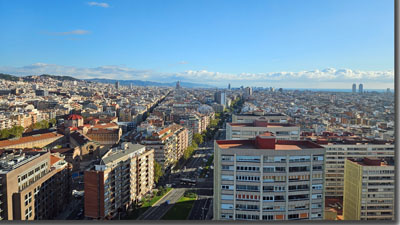 We did sleep late, and after breakfast sort of wasted the morning doing
minor packing. The city is
quite lovely in the morning with all the light-colored buildings glowing
in the early sun.
We did sleep late, and after breakfast sort of wasted the morning doing
minor packing. The city is
quite lovely in the morning with all the light-colored buildings glowing
in the early sun.
 The afternoon was spent on a tour to Montserrat, the monastery and
mountain about an hour outside of town.
While traffic was fairly heavy, we made pretty good time. We could
see the mountain in the distance, and see the craigy outlines as we
climbed to the monestary.
The afternoon was spent on a tour to Montserrat, the monastery and
mountain about an hour outside of town.
While traffic was fairly heavy, we made pretty good time. We could
see the mountain in the distance, and see the craigy outlines as we
climbed to the monestary.
Our guide was an older gentleman who had studied European art history
and political science. He
was certainly knowledgeable about the mountain site and like most
guides, was happy to share his expertise.
Of note, our driver – as did all of our drivers – did a stellar
job. Think about driving in
large city with dense, high speed traffic and you’ve got the picture.
It isn’t difficult, but you have to pay attention and always be
aware. You certainly don’t
see any big wheel pickup trucks or giant SUVs.
Our guide said that it is a magical mountain, and that is why the monks settled here. I'm thinking Sedona Magic but I'm a skeptic. It is a lovely area.
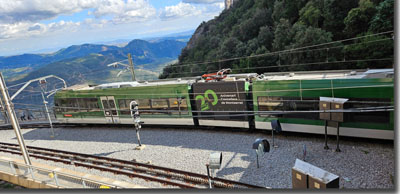 There
is a cog rail line so of course I had to get a photo of a train.
We opted for the more scenic trip on winding switchbacks to the church
complex.
There
is a cog rail line so of course I had to get a photo of a train.
We opted for the more scenic trip on winding switchbacks to the church
complex.
 At
the entrance is a farmers market, which has apparently been going on
since the place was built in 1025. As was the case, most activity
took place around the church complexes as they wre the center of
activity. Entry is through the gate, and up a path to the
monestary, church and chapel.
At
the entrance is a farmers market, which has apparently been going on
since the place was built in 1025. As was the case, most activity
took place around the church complexes as they wre the center of
activity. Entry is through the gate, and up a path to the
monestary, church and chapel.
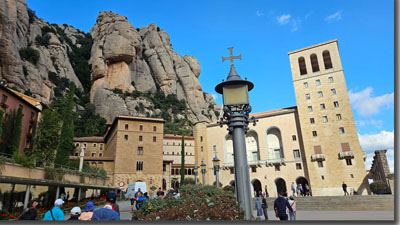 The
weathered and rounded boulders do make for a spectacular setting.
The
weathered and rounded boulders do make for a spectacular setting.
In front of the monestary, which is still in use as a primary school,
are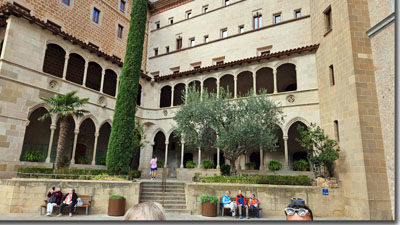 planted four trees. They are the palm, signifying martrydom, the
cypress, for eternal life, the olive for peace, and the laurel, denoting
vistory.
planted four trees. They are the palm, signifying martrydom, the
cypress, for eternal life, the olive for peace, and the laurel, denoting
vistory.
 No
matter where you turned, specatular vistas of the surrounding
countryside could be seen.
No
matter where you turned, specatular vistas of the surrounding
countryside could be seen.
 Entry
is through a semi sheltered courtyard, to the church proper.
Entry
is through a semi sheltered courtyard, to the church proper.

As we had special passes, we did the chapel tour backwards, which
avoided the wait times and the crowds.
The usual decoration and the stained glass really made the place
beautiful.
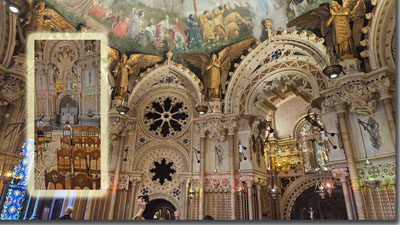 The
interior is the usual ornate guilding and iconography that is a hallmark
of the religious orders. Still, it quite lovely and a sight to
see.
The
interior is the usual ornate guilding and iconography that is a hallmark
of the religious orders. Still, it quite lovely and a sight to
see.

Its big claim to fame is the Black Madonna.
This is an ebony carved figure of the Virgin Mary with Christ on
her lap.
 The
church iteself fits right in to the setting.
The
church iteself fits right in to the setting.
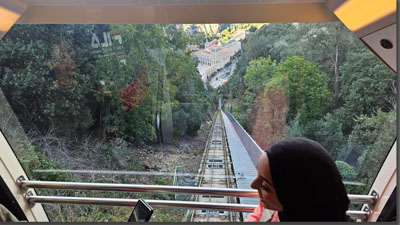 Lynn and I took the funicular to the top of the mountain (around 800
meters) and walked to the top.
Of interest to me was that this was a two-track arrangement, with
spring turnouts at the crossover
point.
You get an amazing view of the countryside from atop the
mountain.
Lynn and I took the funicular to the top of the mountain (around 800
meters) and walked to the top.
Of interest to me was that this was a two-track arrangement, with
spring turnouts at the crossover
point.
You get an amazing view of the countryside from atop the
mountain.

Back in the city it was – hey, time to eat!
And back we went to our favorite little restaurant, Asador El
Bierzo. It turns out this
is a really popular local spot, as it is close to the train station.
Even though we are familiar with the European tipping traditions,
I think our waiter did like us we did always leave him something.
It’s also a good way to unload those left over Euros!
think our waiter did like us we did always leave him something.
It’s also a good way to unload those left over Euros!
We finished the night in the rooftop bar, which offered a lovely
nighttime view of the city.
It was a fitting end to a wonderful two weeks.
Friday, October 11
The morning came entirely too quickly as we were up and out quite early.
The Barcelona airport is large, modern, and efficient.
We breezed through immigration and security controls, as upgraded
air classes apparently have privileges, and settled into the lounge for
a light breakfast. Frankly
we needn’t have bothered as all the airline did was feed us.
The flight back to Philly was uneventful and our entry back into the USA
went quickly and smoothly.
That was followed by our five-hour flight back home.
It was good to get into our own beds.
The trip was a wonderful time.
I was surprised by the mountainous terrain of Portugal.
We could not have been treated better by Viking.
Every aspect of the trip was top-notch.
Our travel companions were delightful and compatible.
As we have found on all our travels, the people are friendly and
welcoming, just as curious about us as we are of them.
As always, the travel was a meaningful experience.